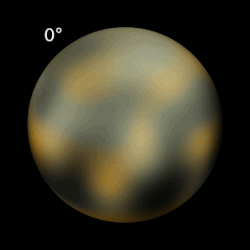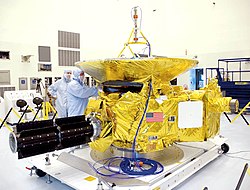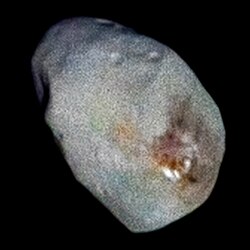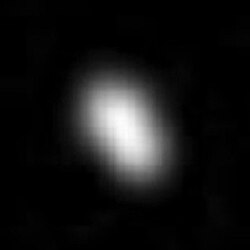Pluto by LORRI, 11 July 2015
IMAGE CAPTION:
http://pluto.jhuapl.edu/Multimedia/Science-Photos/image.php?gallery_id=2&image_id=215
New Horizons' last look at Pluto's Charon-facing hemisphere reveals intriguing geologic details that are of keen interest to mission scientists. This image, taken early the morning of July 11, 2015, shows newly-resolved linear features above the equatorial region that intersect, suggestive of polygonal shapes. This image was captured when the spacecraft was 2.5 million miles (4 million kilometers) from Pluto.
NOTE: North pole is in the upper center of the image.[1]
FILE DESRIPTION:
http://www.nasa.gov/image-feature/new-horizons-last-portrait-of-pluto-s-puzzling-spots
July 11, 2015
New Horizons’ Last Portrait of Pluto’s Puzzling Spots
Edited by Tricia Talbert
Pluto Image
Three billion miles from Earth and just two and a half million miles from Pluto, NASA’s New Horizons spacecraft has taken its best image of four dark spots that continue to captivate.
The spots appear on the side of Pluto that always faces its largest moon, Charon—the face that will be invisible to New Horizons when the spacecraft makes its close flyby the morning of July 14. New Horizons principal investigator Alan Stern of the Southwest Research Institute, Boulder, Colorado, describes this image as “the last, best look that anyone will have of Pluto’s far side for decades to come.”
The spots are connected to a dark belt that circles Pluto’s equatorial region. What continues to pique the interest of scientists is their similar size and even spacing. “It’s weird that they’re spaced so regularly,” says New Horizons program scientist Curt Niebur at NASA Headquarters in Washington. Jeff Moore of NASA’s Ames Research Center, Mountain View, California, is equally intrigued. “We can’t tell whether they’re plateaus or plains, or whether they’re brightness variations on a completely smooth surface.”
The large dark areas are now estimated to be 300 miles (480 kilometers) across, an area roughly the size of the state of Missouri. In comparison with earlier images, we now see that the dark areas are more complex than they initially appeared, while the boundaries between the dark and bright terrains are irregular and sharply defined.
In addition to solving the mystery of the spots, the New Horizons Geology, Geophysics and Imaging team is interested in identifying other surface features such as impact craters, formed when smaller objects struck the dwarf planet. Moore notes, “When we combine images like this of the far side with composition and color data the spacecraft has already acquired but not yet sent to Earth, we expect to be able to read the history of this face of Pluto.”
When New Horizons makes its closest approach to Pluto in just three days, it will focus on the opposing or “encounter hemisphere” of the dwarf planet. On the morning of July 14, New Horizons will pass about 7,800 miles (12,500 kilometers) from the face with a large heart-shaped feature that’s captured the imagination of people around the world.Relevante Bilder
Relevante Artikel
PlutoPluto ist der größte und zweitmassivste bekannte Zwergplanet des Sonnensystems und das am längsten bekannte Objekt des Kuipergürtels. Er bewegt sich auf einer noch exzentrischeren Bahn um die Sonne als der Planet Merkur. Sein Volumen entspricht etwa einem Drittel des Erdmondes. .. weiterlesen



























